NIT5140 Information Security: PGP Encryption Assessment Report
VerifiedAdded on 2023/04/19
|11
|2428
|91
Report
AI Summary
This report provides a detailed assessment of the Pretty Good Privacy (PGP) encryption program. It begins by outlining the security services offered by PGP, including privacy, sender authentication, message integrity, and non-repudiation, and then describes the encryption process step-by-step, including the use of symmetric-key cryptography, data compression, hashing, and public-key cryptography. The report also illustrates the PGP message format and discusses the advantages and disadvantages of PGP certificates. The core of the report is a case study on the EFAIL vulnerability, exploring its impact on the Internet of Things (IoT) landscape, analyzing the vulnerabilities in PGP implementations, and considering the responses from developers and the broader security community. The report concludes by emphasizing the importance of secure PGP implementations and the potential risks associated with vulnerabilities like EFAIL.

Running head: ASSESSMENT OF PRETTY GOOD PRIVACY (PGP) ENCRYPTION
Assessment of Pretty Good Privacy (PGP) Encryption
Student Name
University Name
Note by the Author
Assessment of Pretty Good Privacy (PGP) Encryption
Student Name
University Name
Note by the Author
Paraphrase This Document
Need a fresh take? Get an instant paraphrase of this document with our AI Paraphraser
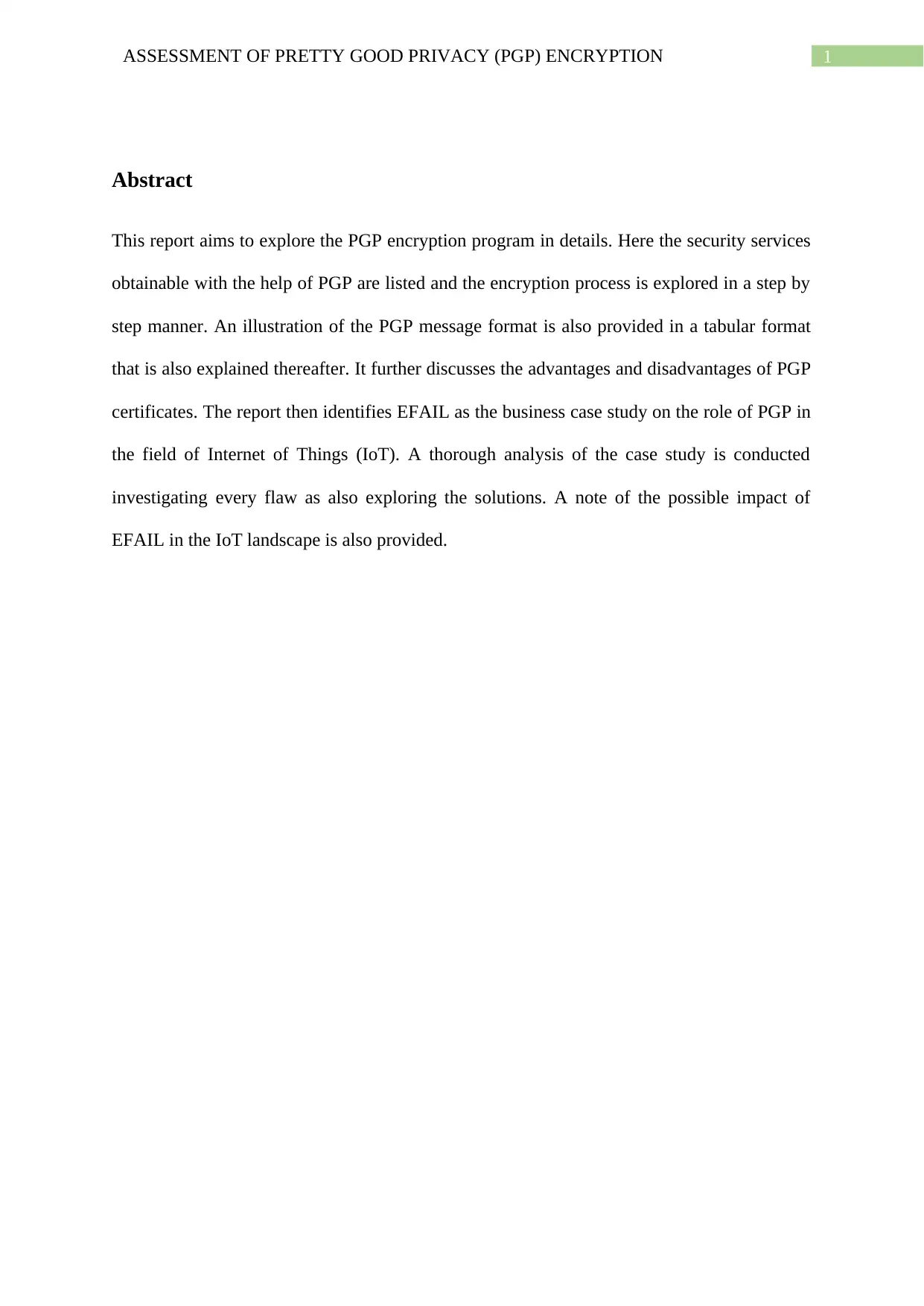
1ASSESSMENT OF PRETTY GOOD PRIVACY (PGP) ENCRYPTION
Abstract
This report aims to explore the PGP encryption program in details. Here the security services
obtainable with the help of PGP are listed and the encryption process is explored in a step by
step manner. An illustration of the PGP message format is also provided in a tabular format
that is also explained thereafter. It further discusses the advantages and disadvantages of PGP
certificates. The report then identifies EFAIL as the business case study on the role of PGP in
the field of Internet of Things (IoT). A thorough analysis of the case study is conducted
investigating every flaw as also exploring the solutions. A note of the possible impact of
EFAIL in the IoT landscape is also provided.
Abstract
This report aims to explore the PGP encryption program in details. Here the security services
obtainable with the help of PGP are listed and the encryption process is explored in a step by
step manner. An illustration of the PGP message format is also provided in a tabular format
that is also explained thereafter. It further discusses the advantages and disadvantages of PGP
certificates. The report then identifies EFAIL as the business case study on the role of PGP in
the field of Internet of Things (IoT). A thorough analysis of the case study is conducted
investigating every flaw as also exploring the solutions. A note of the possible impact of
EFAIL in the IoT landscape is also provided.
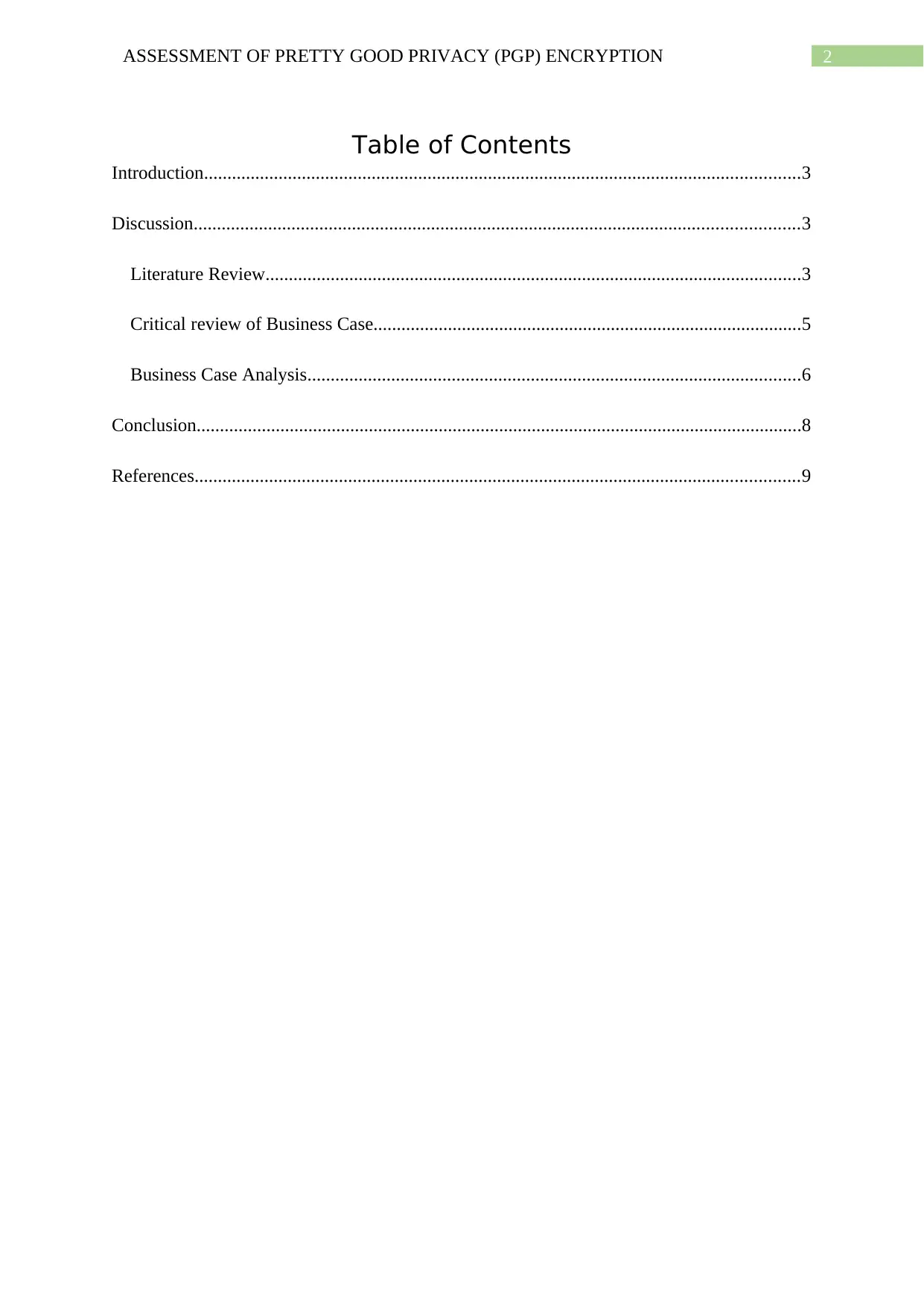
2ASSESSMENT OF PRETTY GOOD PRIVACY (PGP) ENCRYPTION
Table of Contents
Introduction................................................................................................................................3
Discussion..................................................................................................................................3
Literature Review...................................................................................................................3
Critical review of Business Case............................................................................................5
Business Case Analysis..........................................................................................................6
Conclusion..................................................................................................................................8
References..................................................................................................................................9
Table of Contents
Introduction................................................................................................................................3
Discussion..................................................................................................................................3
Literature Review...................................................................................................................3
Critical review of Business Case............................................................................................5
Business Case Analysis..........................................................................................................6
Conclusion..................................................................................................................................8
References..................................................................................................................................9
⊘ This is a preview!⊘
Do you want full access?
Subscribe today to unlock all pages.

Trusted by 1+ million students worldwide
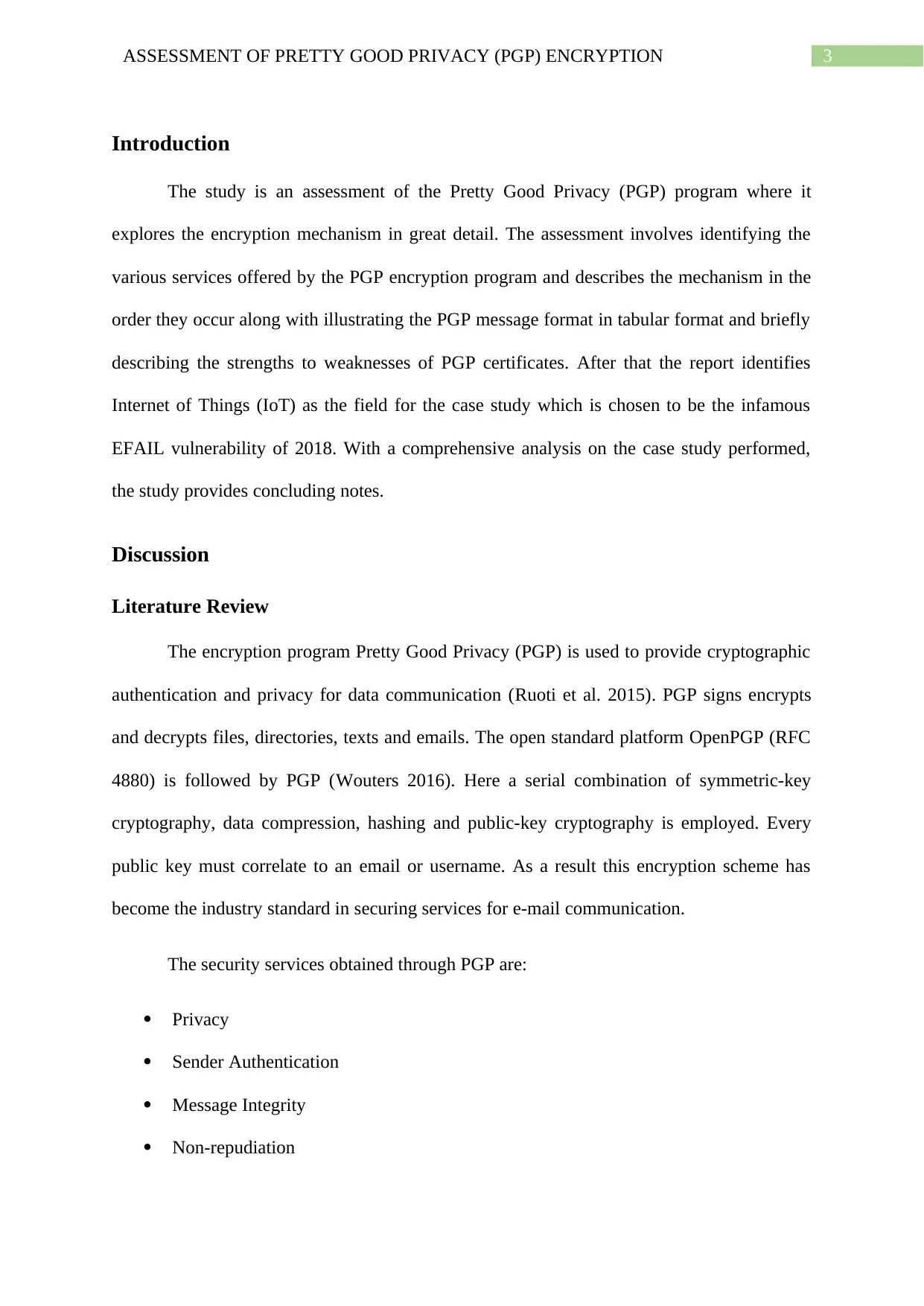
3ASSESSMENT OF PRETTY GOOD PRIVACY (PGP) ENCRYPTION
Introduction
The study is an assessment of the Pretty Good Privacy (PGP) program where it
explores the encryption mechanism in great detail. The assessment involves identifying the
various services offered by the PGP encryption program and describes the mechanism in the
order they occur along with illustrating the PGP message format in tabular format and briefly
describing the strengths to weaknesses of PGP certificates. After that the report identifies
Internet of Things (IoT) as the field for the case study which is chosen to be the infamous
EFAIL vulnerability of 2018. With a comprehensive analysis on the case study performed,
the study provides concluding notes.
Discussion
Literature Review
The encryption program Pretty Good Privacy (PGP) is used to provide cryptographic
authentication and privacy for data communication (Ruoti et al. 2015). PGP signs encrypts
and decrypts files, directories, texts and emails. The open standard platform OpenPGP (RFC
4880) is followed by PGP (Wouters 2016). Here a serial combination of symmetric-key
cryptography, data compression, hashing and public-key cryptography is employed. Every
public key must correlate to an email or username. As a result this encryption scheme has
become the industry standard in securing services for e-mail communication.
The security services obtained through PGP are:
Privacy
Sender Authentication
Message Integrity
Non-repudiation
Introduction
The study is an assessment of the Pretty Good Privacy (PGP) program where it
explores the encryption mechanism in great detail. The assessment involves identifying the
various services offered by the PGP encryption program and describes the mechanism in the
order they occur along with illustrating the PGP message format in tabular format and briefly
describing the strengths to weaknesses of PGP certificates. After that the report identifies
Internet of Things (IoT) as the field for the case study which is chosen to be the infamous
EFAIL vulnerability of 2018. With a comprehensive analysis on the case study performed,
the study provides concluding notes.
Discussion
Literature Review
The encryption program Pretty Good Privacy (PGP) is used to provide cryptographic
authentication and privacy for data communication (Ruoti et al. 2015). PGP signs encrypts
and decrypts files, directories, texts and emails. The open standard platform OpenPGP (RFC
4880) is followed by PGP (Wouters 2016). Here a serial combination of symmetric-key
cryptography, data compression, hashing and public-key cryptography is employed. Every
public key must correlate to an email or username. As a result this encryption scheme has
become the industry standard in securing services for e-mail communication.
The security services obtained through PGP are:
Privacy
Sender Authentication
Message Integrity
Non-repudiation
Paraphrase This Document
Need a fresh take? Get an instant paraphrase of this document with our AI Paraphraser
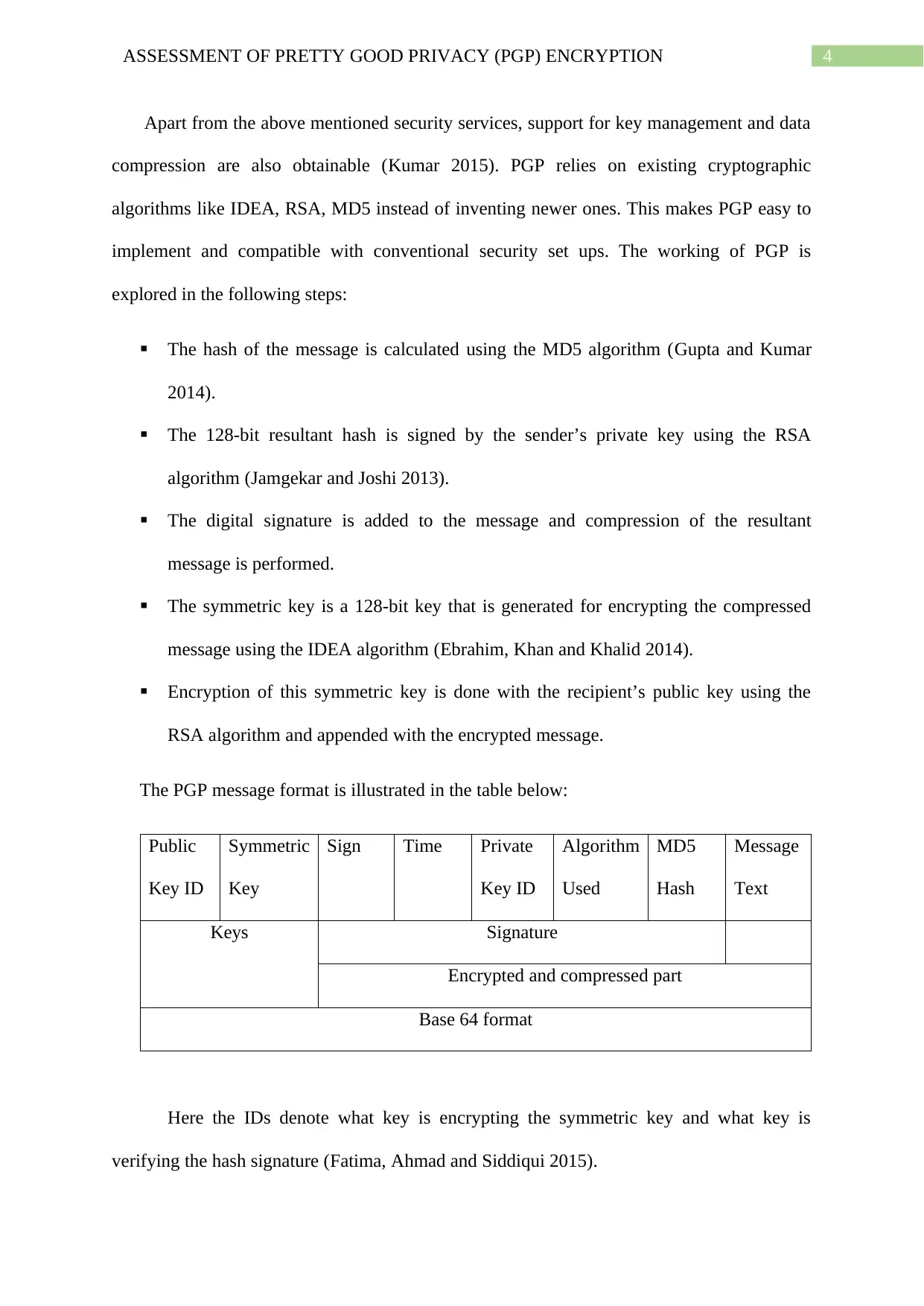
4ASSESSMENT OF PRETTY GOOD PRIVACY (PGP) ENCRYPTION
Apart from the above mentioned security services, support for key management and data
compression are also obtainable (Kumar 2015). PGP relies on existing cryptographic
algorithms like IDEA, RSA, MD5 instead of inventing newer ones. This makes PGP easy to
implement and compatible with conventional security set ups. The working of PGP is
explored in the following steps:
The hash of the message is calculated using the MD5 algorithm (Gupta and Kumar
2014).
The 128-bit resultant hash is signed by the sender’s private key using the RSA
algorithm (Jamgekar and Joshi 2013).
The digital signature is added to the message and compression of the resultant
message is performed.
The symmetric key is a 128-bit key that is generated for encrypting the compressed
message using the IDEA algorithm (Ebrahim, Khan and Khalid 2014).
Encryption of this symmetric key is done with the recipient’s public key using the
RSA algorithm and appended with the encrypted message.
The PGP message format is illustrated in the table below:
Public
Key ID
Symmetric
Key
Sign Time Private
Key ID
Algorithm
Used
MD5
Hash
Message
Text
Keys Signature
Encrypted and compressed part
Base 64 format
Here the IDs denote what key is encrypting the symmetric key and what key is
verifying the hash signature (Fatima, Ahmad and Siddiqui 2015).
Apart from the above mentioned security services, support for key management and data
compression are also obtainable (Kumar 2015). PGP relies on existing cryptographic
algorithms like IDEA, RSA, MD5 instead of inventing newer ones. This makes PGP easy to
implement and compatible with conventional security set ups. The working of PGP is
explored in the following steps:
The hash of the message is calculated using the MD5 algorithm (Gupta and Kumar
2014).
The 128-bit resultant hash is signed by the sender’s private key using the RSA
algorithm (Jamgekar and Joshi 2013).
The digital signature is added to the message and compression of the resultant
message is performed.
The symmetric key is a 128-bit key that is generated for encrypting the compressed
message using the IDEA algorithm (Ebrahim, Khan and Khalid 2014).
Encryption of this symmetric key is done with the recipient’s public key using the
RSA algorithm and appended with the encrypted message.
The PGP message format is illustrated in the table below:
Public
Key ID
Symmetric
Key
Sign Time Private
Key ID
Algorithm
Used
MD5
Hash
Message
Text
Keys Signature
Encrypted and compressed part
Base 64 format
Here the IDs denote what key is encrypting the symmetric key and what key is
verifying the hash signature (Fatima, Ahmad and Siddiqui 2015).
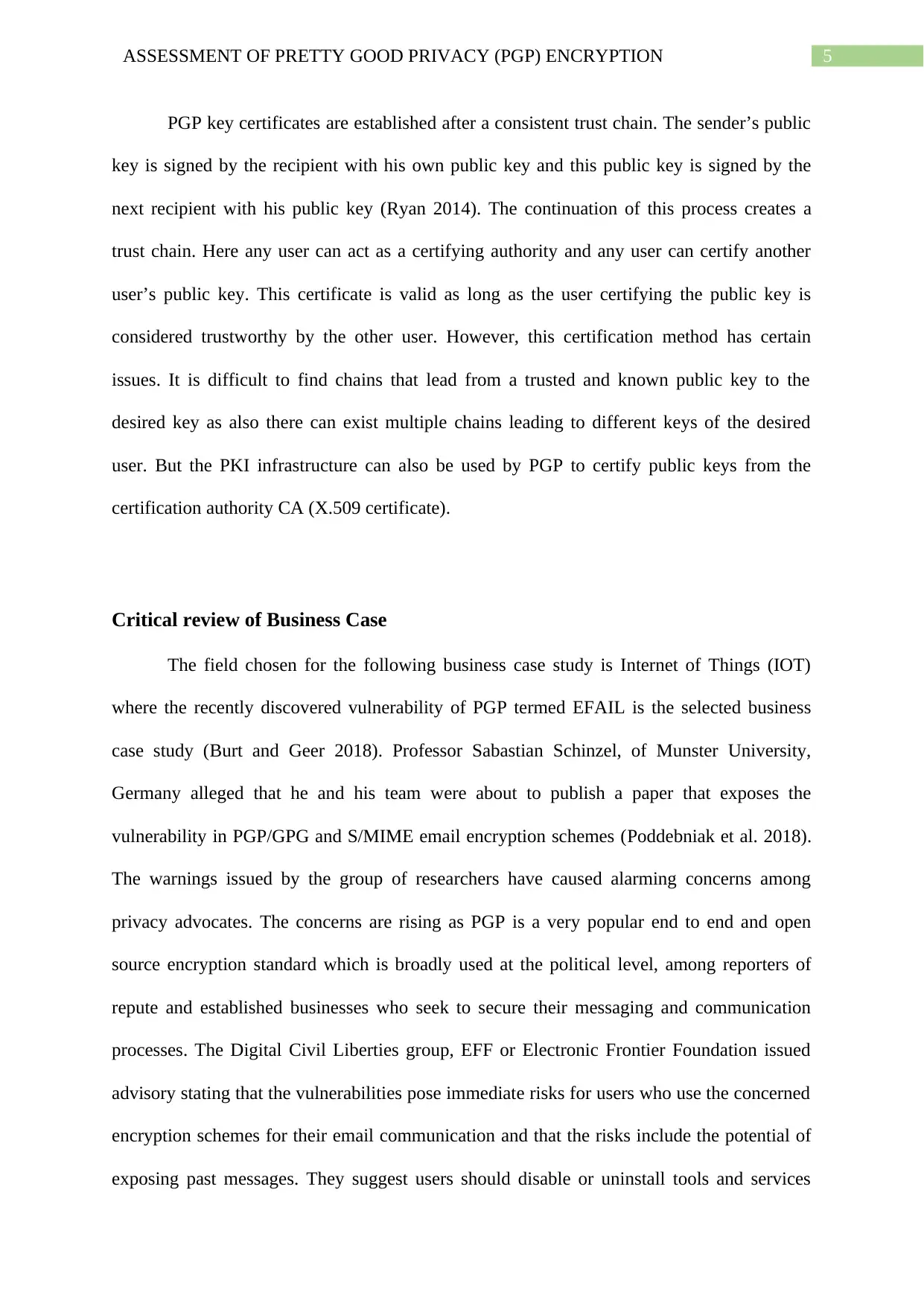
5ASSESSMENT OF PRETTY GOOD PRIVACY (PGP) ENCRYPTION
PGP key certificates are established after a consistent trust chain. The sender’s public
key is signed by the recipient with his own public key and this public key is signed by the
next recipient with his public key (Ryan 2014). The continuation of this process creates a
trust chain. Here any user can act as a certifying authority and any user can certify another
user’s public key. This certificate is valid as long as the user certifying the public key is
considered trustworthy by the other user. However, this certification method has certain
issues. It is difficult to find chains that lead from a trusted and known public key to the
desired key as also there can exist multiple chains leading to different keys of the desired
user. But the PKI infrastructure can also be used by PGP to certify public keys from the
certification authority CA (X.509 certificate).
Critical review of Business Case
The field chosen for the following business case study is Internet of Things (IOT)
where the recently discovered vulnerability of PGP termed EFAIL is the selected business
case study (Burt and Geer 2018). Professor Sabastian Schinzel, of Munster University,
Germany alleged that he and his team were about to publish a paper that exposes the
vulnerability in PGP/GPG and S/MIME email encryption schemes (Poddebniak et al. 2018).
The warnings issued by the group of researchers have caused alarming concerns among
privacy advocates. The concerns are rising as PGP is a very popular end to end and open
source encryption standard which is broadly used at the political level, among reporters of
repute and established businesses who seek to secure their messaging and communication
processes. The Digital Civil Liberties group, EFF or Electronic Frontier Foundation issued
advisory stating that the vulnerabilities pose immediate risks for users who use the concerned
encryption schemes for their email communication and that the risks include the potential of
exposing past messages. They suggest users should disable or uninstall tools and services
PGP key certificates are established after a consistent trust chain. The sender’s public
key is signed by the recipient with his own public key and this public key is signed by the
next recipient with his public key (Ryan 2014). The continuation of this process creates a
trust chain. Here any user can act as a certifying authority and any user can certify another
user’s public key. This certificate is valid as long as the user certifying the public key is
considered trustworthy by the other user. However, this certification method has certain
issues. It is difficult to find chains that lead from a trusted and known public key to the
desired key as also there can exist multiple chains leading to different keys of the desired
user. But the PKI infrastructure can also be used by PGP to certify public keys from the
certification authority CA (X.509 certificate).
Critical review of Business Case
The field chosen for the following business case study is Internet of Things (IOT)
where the recently discovered vulnerability of PGP termed EFAIL is the selected business
case study (Burt and Geer 2018). Professor Sabastian Schinzel, of Munster University,
Germany alleged that he and his team were about to publish a paper that exposes the
vulnerability in PGP/GPG and S/MIME email encryption schemes (Poddebniak et al. 2018).
The warnings issued by the group of researchers have caused alarming concerns among
privacy advocates. The concerns are rising as PGP is a very popular end to end and open
source encryption standard which is broadly used at the political level, among reporters of
repute and established businesses who seek to secure their messaging and communication
processes. The Digital Civil Liberties group, EFF or Electronic Frontier Foundation issued
advisory stating that the vulnerabilities pose immediate risks for users who use the concerned
encryption schemes for their email communication and that the risks include the potential of
exposing past messages. They suggest users should disable or uninstall tools and services
⊘ This is a preview!⊘
Do you want full access?
Subscribe today to unlock all pages.

Trusted by 1+ million students worldwide
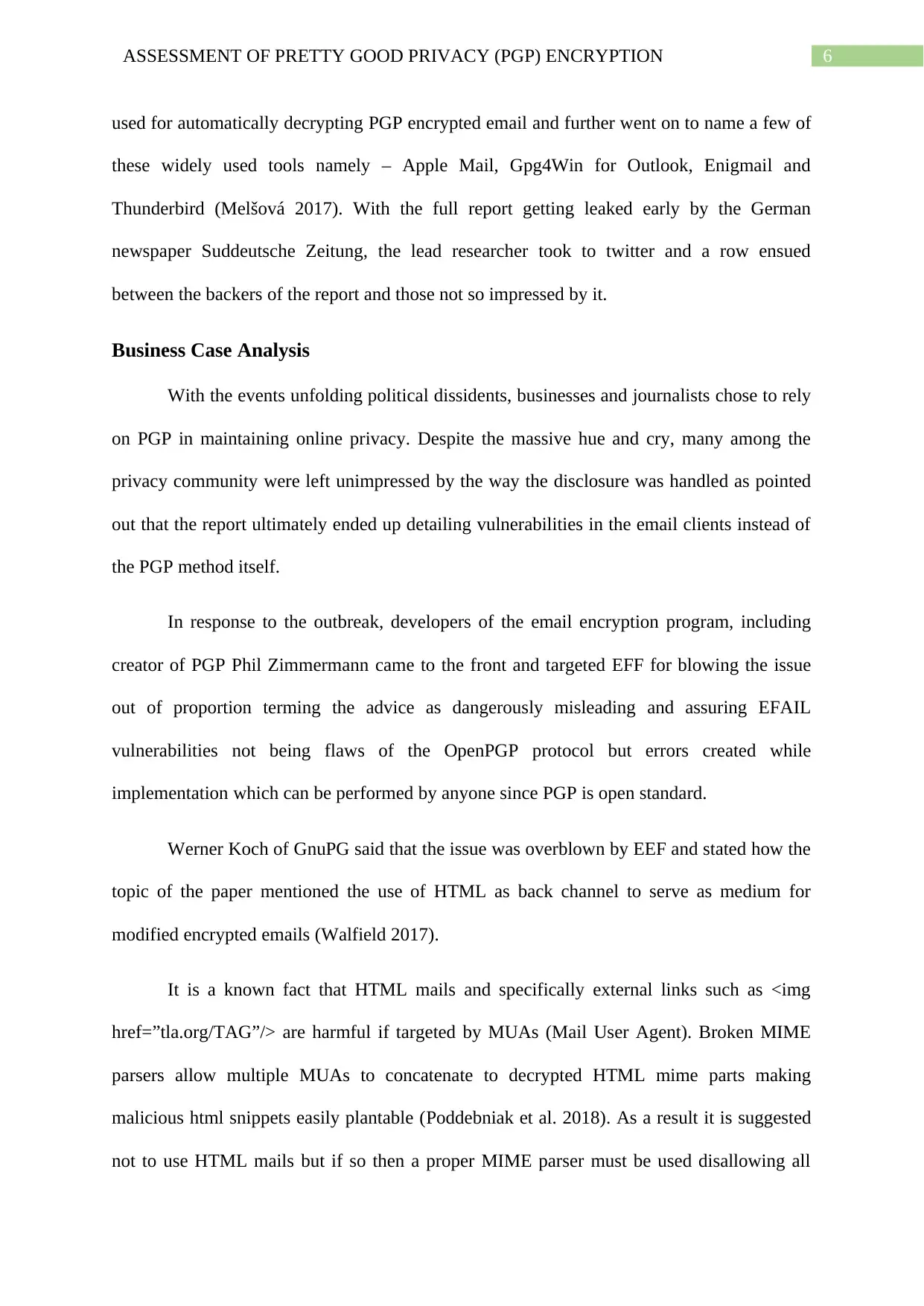
6ASSESSMENT OF PRETTY GOOD PRIVACY (PGP) ENCRYPTION
used for automatically decrypting PGP encrypted email and further went on to name a few of
these widely used tools namely – Apple Mail, Gpg4Win for Outlook, Enigmail and
Thunderbird (Melšová 2017). With the full report getting leaked early by the German
newspaper Suddeutsche Zeitung, the lead researcher took to twitter and a row ensued
between the backers of the report and those not so impressed by it.
Business Case Analysis
With the events unfolding political dissidents, businesses and journalists chose to rely
on PGP in maintaining online privacy. Despite the massive hue and cry, many among the
privacy community were left unimpressed by the way the disclosure was handled as pointed
out that the report ultimately ended up detailing vulnerabilities in the email clients instead of
the PGP method itself.
In response to the outbreak, developers of the email encryption program, including
creator of PGP Phil Zimmermann came to the front and targeted EFF for blowing the issue
out of proportion terming the advice as dangerously misleading and assuring EFAIL
vulnerabilities not being flaws of the OpenPGP protocol but errors created while
implementation which can be performed by anyone since PGP is open standard.
Werner Koch of GnuPG said that the issue was overblown by EEF and stated how the
topic of the paper mentioned the use of HTML as back channel to serve as medium for
modified encrypted emails (Walfield 2017).
It is a known fact that HTML mails and specifically external links such as <img
href=”tla.org/TAG”/> are harmful if targeted by MUAs (Mail User Agent). Broken MIME
parsers allow multiple MUAs to concatenate to decrypted HTML mime parts making
malicious html snippets easily plantable (Poddebniak et al. 2018). As a result it is suggested
not to use HTML mails but if so then a proper MIME parser must be used disallowing all
used for automatically decrypting PGP encrypted email and further went on to name a few of
these widely used tools namely – Apple Mail, Gpg4Win for Outlook, Enigmail and
Thunderbird (Melšová 2017). With the full report getting leaked early by the German
newspaper Suddeutsche Zeitung, the lead researcher took to twitter and a row ensued
between the backers of the report and those not so impressed by it.
Business Case Analysis
With the events unfolding political dissidents, businesses and journalists chose to rely
on PGP in maintaining online privacy. Despite the massive hue and cry, many among the
privacy community were left unimpressed by the way the disclosure was handled as pointed
out that the report ultimately ended up detailing vulnerabilities in the email clients instead of
the PGP method itself.
In response to the outbreak, developers of the email encryption program, including
creator of PGP Phil Zimmermann came to the front and targeted EFF for blowing the issue
out of proportion terming the advice as dangerously misleading and assuring EFAIL
vulnerabilities not being flaws of the OpenPGP protocol but errors created while
implementation which can be performed by anyone since PGP is open standard.
Werner Koch of GnuPG said that the issue was overblown by EEF and stated how the
topic of the paper mentioned the use of HTML as back channel to serve as medium for
modified encrypted emails (Walfield 2017).
It is a known fact that HTML mails and specifically external links such as <img
href=”tla.org/TAG”/> are harmful if targeted by MUAs (Mail User Agent). Broken MIME
parsers allow multiple MUAs to concatenate to decrypted HTML mime parts making
malicious html snippets easily plantable (Poddebniak et al. 2018). As a result it is suggested
not to use HTML mails but if so then a proper MIME parser must be used disallowing all
Paraphrase This Document
Need a fresh take? Get an instant paraphrase of this document with our AI Paraphraser
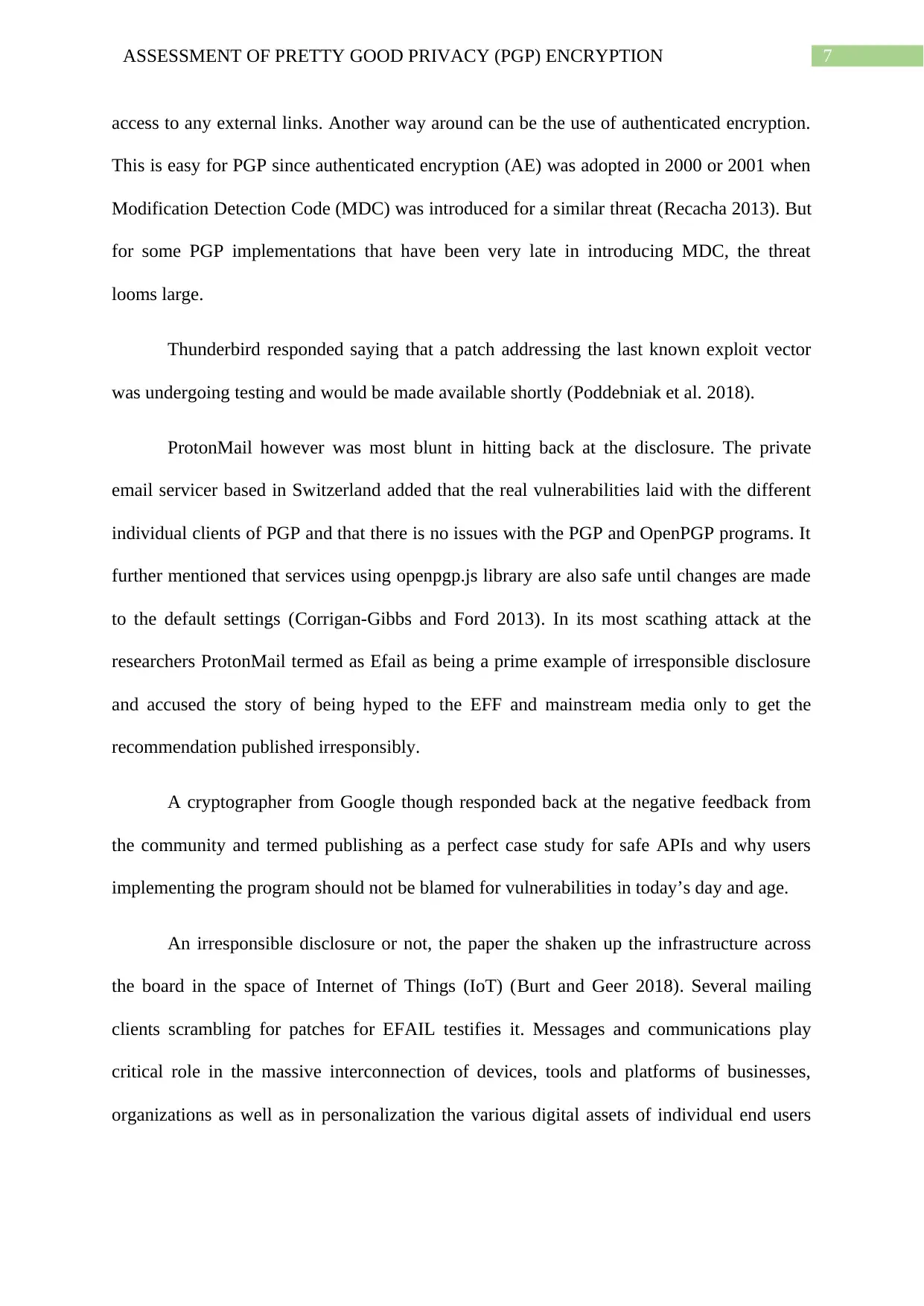
7ASSESSMENT OF PRETTY GOOD PRIVACY (PGP) ENCRYPTION
access to any external links. Another way around can be the use of authenticated encryption.
This is easy for PGP since authenticated encryption (AE) was adopted in 2000 or 2001 when
Modification Detection Code (MDC) was introduced for a similar threat (Recacha 2013). But
for some PGP implementations that have been very late in introducing MDC, the threat
looms large.
Thunderbird responded saying that a patch addressing the last known exploit vector
was undergoing testing and would be made available shortly (Poddebniak et al. 2018).
ProtonMail however was most blunt in hitting back at the disclosure. The private
email servicer based in Switzerland added that the real vulnerabilities laid with the different
individual clients of PGP and that there is no issues with the PGP and OpenPGP programs. It
further mentioned that services using openpgp.js library are also safe until changes are made
to the default settings (Corrigan-Gibbs and Ford 2013). In its most scathing attack at the
researchers ProtonMail termed as Efail as being a prime example of irresponsible disclosure
and accused the story of being hyped to the EFF and mainstream media only to get the
recommendation published irresponsibly.
A cryptographer from Google though responded back at the negative feedback from
the community and termed publishing as a perfect case study for safe APIs and why users
implementing the program should not be blamed for vulnerabilities in today’s day and age.
An irresponsible disclosure or not, the paper the shaken up the infrastructure across
the board in the space of Internet of Things (IoT) (Burt and Geer 2018). Several mailing
clients scrambling for patches for EFAIL testifies it. Messages and communications play
critical role in the massive interconnection of devices, tools and platforms of businesses,
organizations as well as in personalization the various digital assets of individual end users
access to any external links. Another way around can be the use of authenticated encryption.
This is easy for PGP since authenticated encryption (AE) was adopted in 2000 or 2001 when
Modification Detection Code (MDC) was introduced for a similar threat (Recacha 2013). But
for some PGP implementations that have been very late in introducing MDC, the threat
looms large.
Thunderbird responded saying that a patch addressing the last known exploit vector
was undergoing testing and would be made available shortly (Poddebniak et al. 2018).
ProtonMail however was most blunt in hitting back at the disclosure. The private
email servicer based in Switzerland added that the real vulnerabilities laid with the different
individual clients of PGP and that there is no issues with the PGP and OpenPGP programs. It
further mentioned that services using openpgp.js library are also safe until changes are made
to the default settings (Corrigan-Gibbs and Ford 2013). In its most scathing attack at the
researchers ProtonMail termed as Efail as being a prime example of irresponsible disclosure
and accused the story of being hyped to the EFF and mainstream media only to get the
recommendation published irresponsibly.
A cryptographer from Google though responded back at the negative feedback from
the community and termed publishing as a perfect case study for safe APIs and why users
implementing the program should not be blamed for vulnerabilities in today’s day and age.
An irresponsible disclosure or not, the paper the shaken up the infrastructure across
the board in the space of Internet of Things (IoT) (Burt and Geer 2018). Several mailing
clients scrambling for patches for EFAIL testifies it. Messages and communications play
critical role in the massive interconnection of devices, tools and platforms of businesses,
organizations as well as in personalization the various digital assets of individual end users
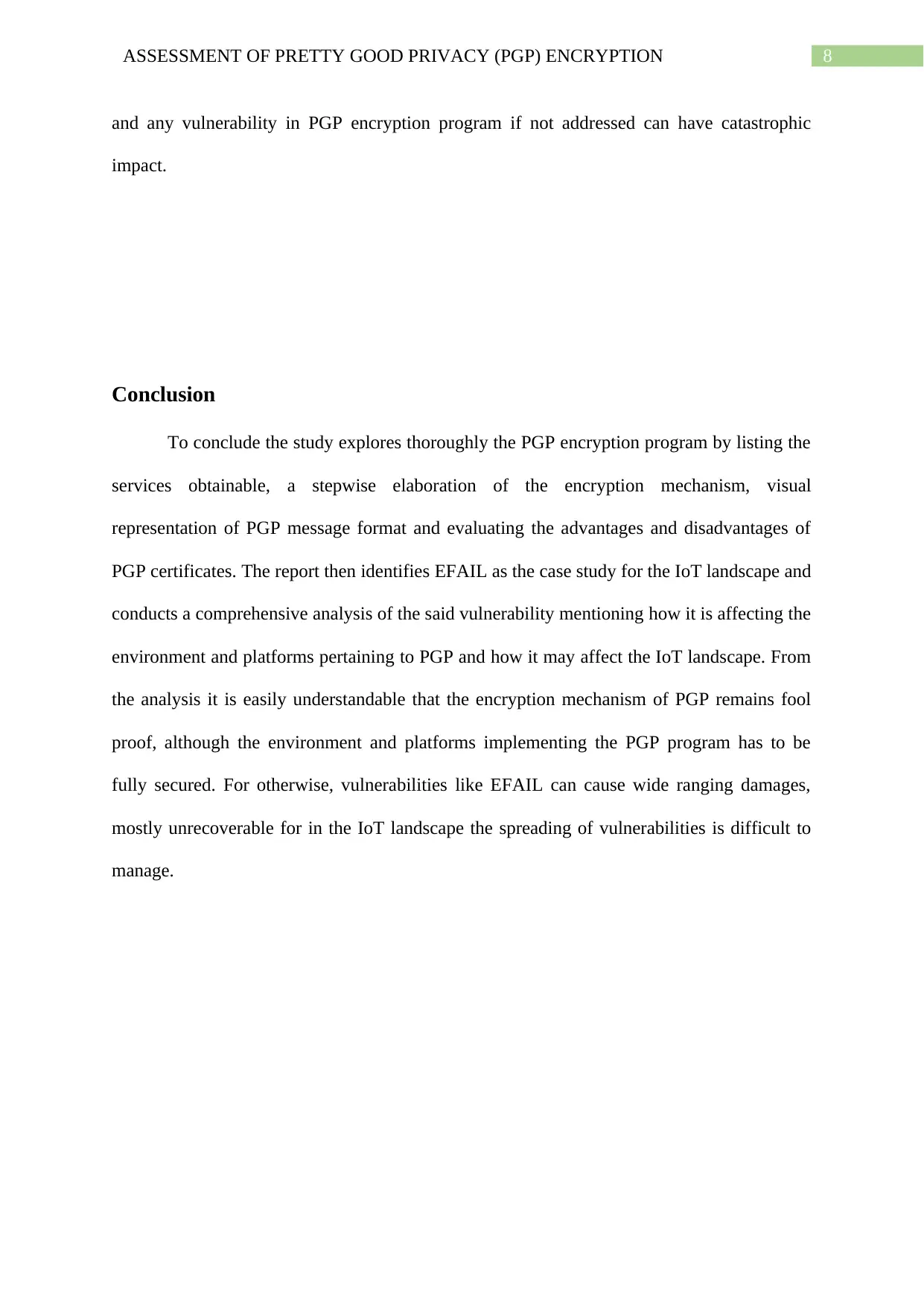
8ASSESSMENT OF PRETTY GOOD PRIVACY (PGP) ENCRYPTION
and any vulnerability in PGP encryption program if not addressed can have catastrophic
impact.
Conclusion
To conclude the study explores thoroughly the PGP encryption program by listing the
services obtainable, a stepwise elaboration of the encryption mechanism, visual
representation of PGP message format and evaluating the advantages and disadvantages of
PGP certificates. The report then identifies EFAIL as the case study for the IoT landscape and
conducts a comprehensive analysis of the said vulnerability mentioning how it is affecting the
environment and platforms pertaining to PGP and how it may affect the IoT landscape. From
the analysis it is easily understandable that the encryption mechanism of PGP remains fool
proof, although the environment and platforms implementing the PGP program has to be
fully secured. For otherwise, vulnerabilities like EFAIL can cause wide ranging damages,
mostly unrecoverable for in the IoT landscape the spreading of vulnerabilities is difficult to
manage.
and any vulnerability in PGP encryption program if not addressed can have catastrophic
impact.
Conclusion
To conclude the study explores thoroughly the PGP encryption program by listing the
services obtainable, a stepwise elaboration of the encryption mechanism, visual
representation of PGP message format and evaluating the advantages and disadvantages of
PGP certificates. The report then identifies EFAIL as the case study for the IoT landscape and
conducts a comprehensive analysis of the said vulnerability mentioning how it is affecting the
environment and platforms pertaining to PGP and how it may affect the IoT landscape. From
the analysis it is easily understandable that the encryption mechanism of PGP remains fool
proof, although the environment and platforms implementing the PGP program has to be
fully secured. For otherwise, vulnerabilities like EFAIL can cause wide ranging damages,
mostly unrecoverable for in the IoT landscape the spreading of vulnerabilities is difficult to
manage.
⊘ This is a preview!⊘
Do you want full access?
Subscribe today to unlock all pages.

Trusted by 1+ million students worldwide
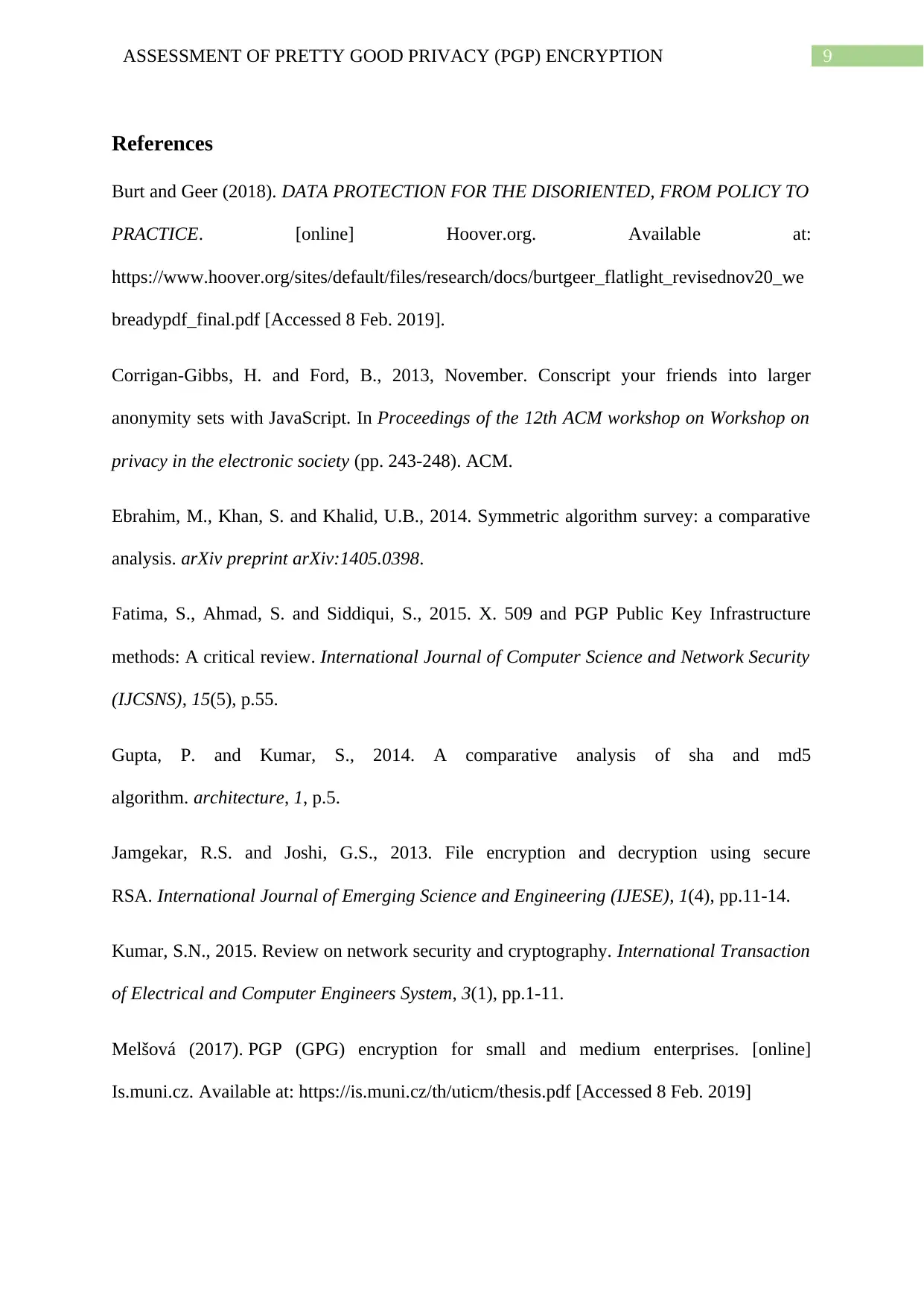
9ASSESSMENT OF PRETTY GOOD PRIVACY (PGP) ENCRYPTION
References
Burt and Geer (2018). DATA PROTECTION FOR THE DISORIENTED, FROM POLICY TO
PRACTICE. [online] Hoover.org. Available at:
https://www.hoover.org/sites/default/files/research/docs/burtgeer_flatlight_revisednov20_we
breadypdf_final.pdf [Accessed 8 Feb. 2019].
Corrigan-Gibbs, H. and Ford, B., 2013, November. Conscript your friends into larger
anonymity sets with JavaScript. In Proceedings of the 12th ACM workshop on Workshop on
privacy in the electronic society (pp. 243-248). ACM.
Ebrahim, M., Khan, S. and Khalid, U.B., 2014. Symmetric algorithm survey: a comparative
analysis. arXiv preprint arXiv:1405.0398.
Fatima, S., Ahmad, S. and Siddiqui, S., 2015. X. 509 and PGP Public Key Infrastructure
methods: A critical review. International Journal of Computer Science and Network Security
(IJCSNS), 15(5), p.55.
Gupta, P. and Kumar, S., 2014. A comparative analysis of sha and md5
algorithm. architecture, 1, p.5.
Jamgekar, R.S. and Joshi, G.S., 2013. File encryption and decryption using secure
RSA. International Journal of Emerging Science and Engineering (IJESE), 1(4), pp.11-14.
Kumar, S.N., 2015. Review on network security and cryptography. International Transaction
of Electrical and Computer Engineers System, 3(1), pp.1-11.
Melšová (2017). PGP (GPG) encryption for small and medium enterprises. [online]
Is.muni.cz. Available at: https://is.muni.cz/th/uticm/thesis.pdf [Accessed 8 Feb. 2019]
References
Burt and Geer (2018). DATA PROTECTION FOR THE DISORIENTED, FROM POLICY TO
PRACTICE. [online] Hoover.org. Available at:
https://www.hoover.org/sites/default/files/research/docs/burtgeer_flatlight_revisednov20_we
breadypdf_final.pdf [Accessed 8 Feb. 2019].
Corrigan-Gibbs, H. and Ford, B., 2013, November. Conscript your friends into larger
anonymity sets with JavaScript. In Proceedings of the 12th ACM workshop on Workshop on
privacy in the electronic society (pp. 243-248). ACM.
Ebrahim, M., Khan, S. and Khalid, U.B., 2014. Symmetric algorithm survey: a comparative
analysis. arXiv preprint arXiv:1405.0398.
Fatima, S., Ahmad, S. and Siddiqui, S., 2015. X. 509 and PGP Public Key Infrastructure
methods: A critical review. International Journal of Computer Science and Network Security
(IJCSNS), 15(5), p.55.
Gupta, P. and Kumar, S., 2014. A comparative analysis of sha and md5
algorithm. architecture, 1, p.5.
Jamgekar, R.S. and Joshi, G.S., 2013. File encryption and decryption using secure
RSA. International Journal of Emerging Science and Engineering (IJESE), 1(4), pp.11-14.
Kumar, S.N., 2015. Review on network security and cryptography. International Transaction
of Electrical and Computer Engineers System, 3(1), pp.1-11.
Melšová (2017). PGP (GPG) encryption for small and medium enterprises. [online]
Is.muni.cz. Available at: https://is.muni.cz/th/uticm/thesis.pdf [Accessed 8 Feb. 2019]
Paraphrase This Document
Need a fresh take? Get an instant paraphrase of this document with our AI Paraphraser
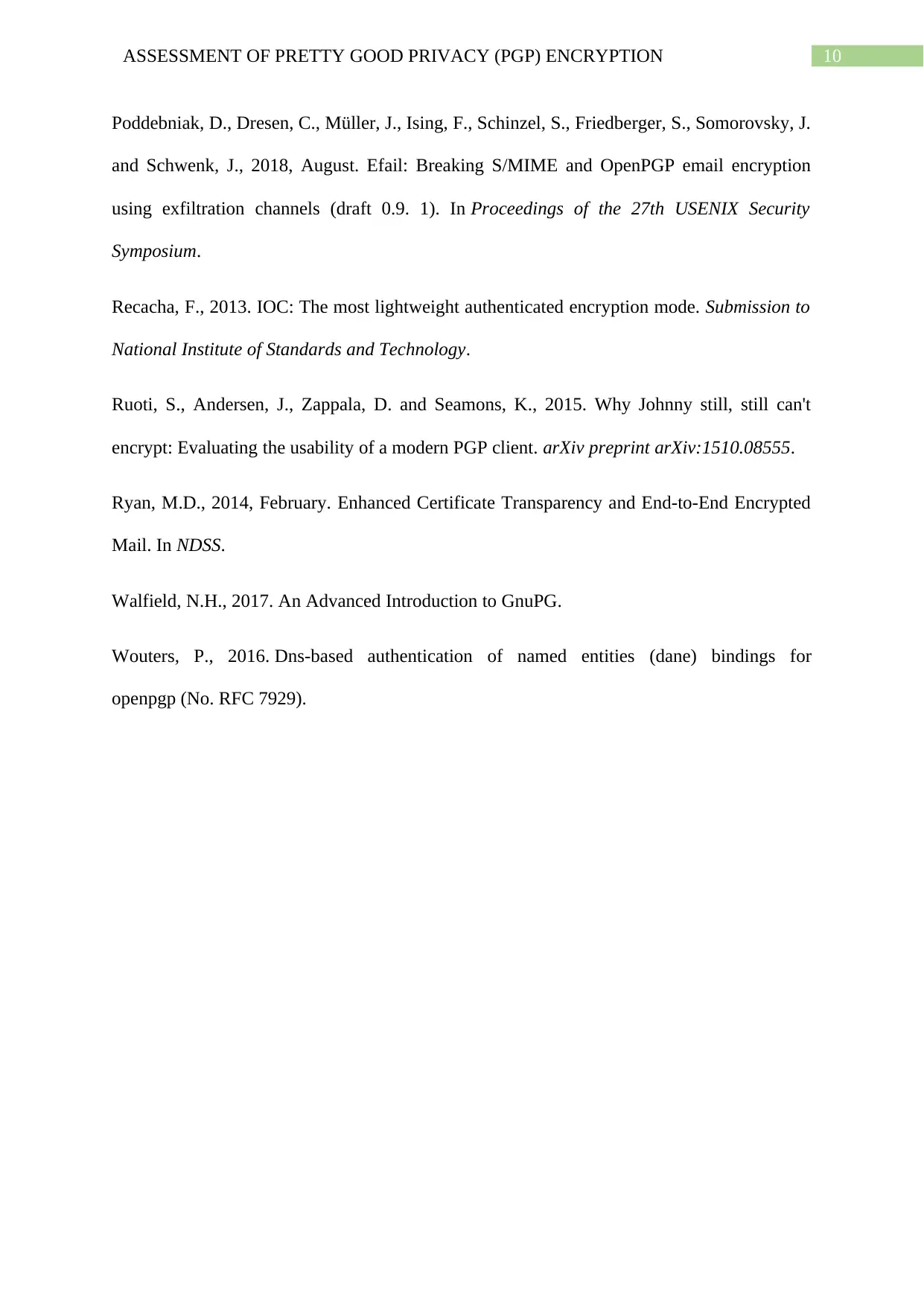
10ASSESSMENT OF PRETTY GOOD PRIVACY (PGP) ENCRYPTION
Poddebniak, D., Dresen, C., Müller, J., Ising, F., Schinzel, S., Friedberger, S., Somorovsky, J.
and Schwenk, J., 2018, August. Efail: Breaking S/MIME and OpenPGP email encryption
using exfiltration channels (draft 0.9. 1). In Proceedings of the 27th USENIX Security
Symposium.
Recacha, F., 2013. IOC: The most lightweight authenticated encryption mode. Submission to
National Institute of Standards and Technology.
Ruoti, S., Andersen, J., Zappala, D. and Seamons, K., 2015. Why Johnny still, still can't
encrypt: Evaluating the usability of a modern PGP client. arXiv preprint arXiv:1510.08555.
Ryan, M.D., 2014, February. Enhanced Certificate Transparency and End-to-End Encrypted
Mail. In NDSS.
Walfield, N.H., 2017. An Advanced Introduction to GnuPG.
Wouters, P., 2016. Dns-based authentication of named entities (dane) bindings for
openpgp (No. RFC 7929).
Poddebniak, D., Dresen, C., Müller, J., Ising, F., Schinzel, S., Friedberger, S., Somorovsky, J.
and Schwenk, J., 2018, August. Efail: Breaking S/MIME and OpenPGP email encryption
using exfiltration channels (draft 0.9. 1). In Proceedings of the 27th USENIX Security
Symposium.
Recacha, F., 2013. IOC: The most lightweight authenticated encryption mode. Submission to
National Institute of Standards and Technology.
Ruoti, S., Andersen, J., Zappala, D. and Seamons, K., 2015. Why Johnny still, still can't
encrypt: Evaluating the usability of a modern PGP client. arXiv preprint arXiv:1510.08555.
Ryan, M.D., 2014, February. Enhanced Certificate Transparency and End-to-End Encrypted
Mail. In NDSS.
Walfield, N.H., 2017. An Advanced Introduction to GnuPG.
Wouters, P., 2016. Dns-based authentication of named entities (dane) bindings for
openpgp (No. RFC 7929).
1 out of 11
Your All-in-One AI-Powered Toolkit for Academic Success.
+13062052269
info@desklib.com
Available 24*7 on WhatsApp / Email
![[object Object]](/_next/static/media/star-bottom.7253800d.svg)
Unlock your academic potential
Copyright © 2020–2025 A2Z Services. All Rights Reserved. Developed and managed by ZUCOL.


